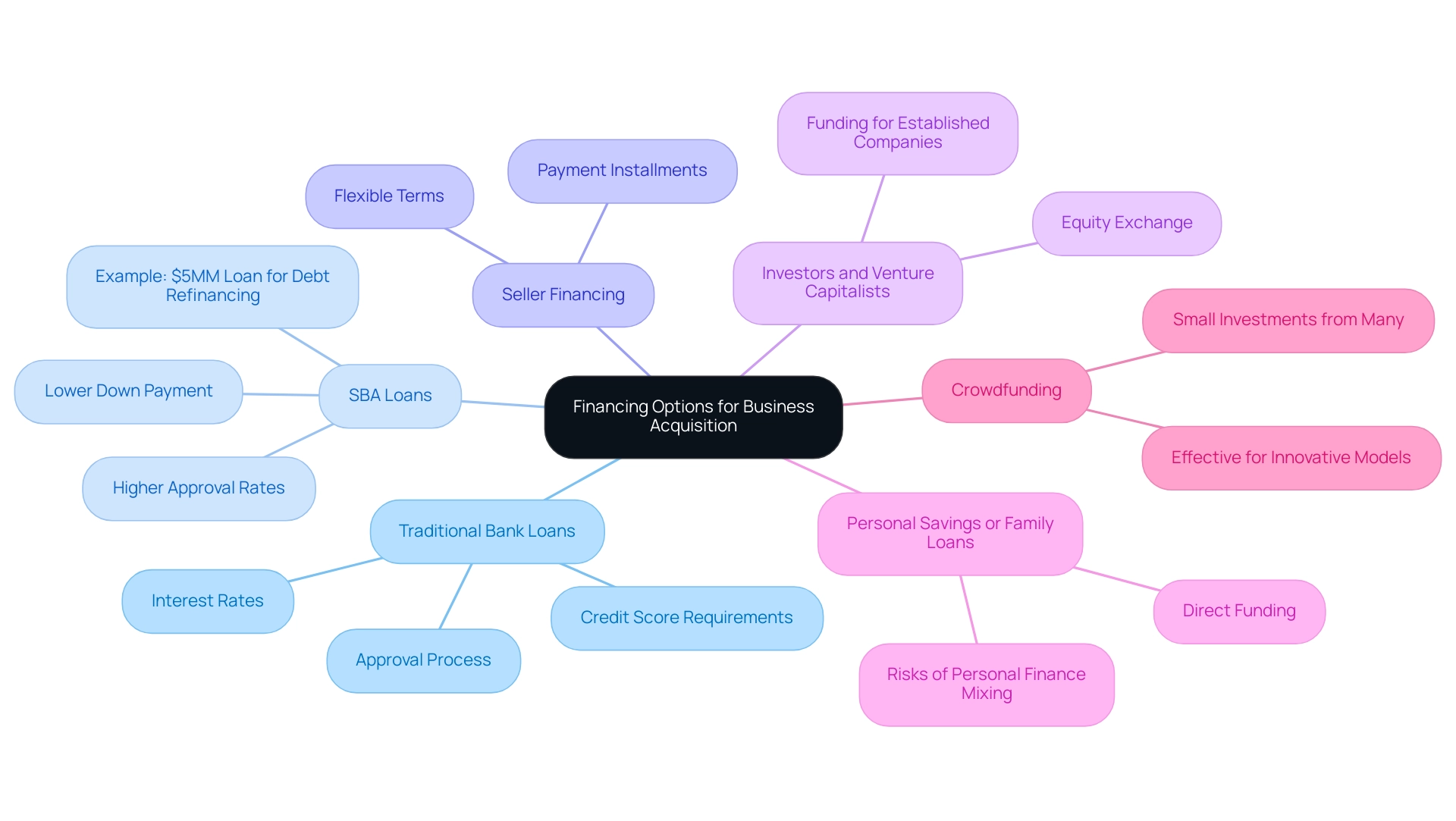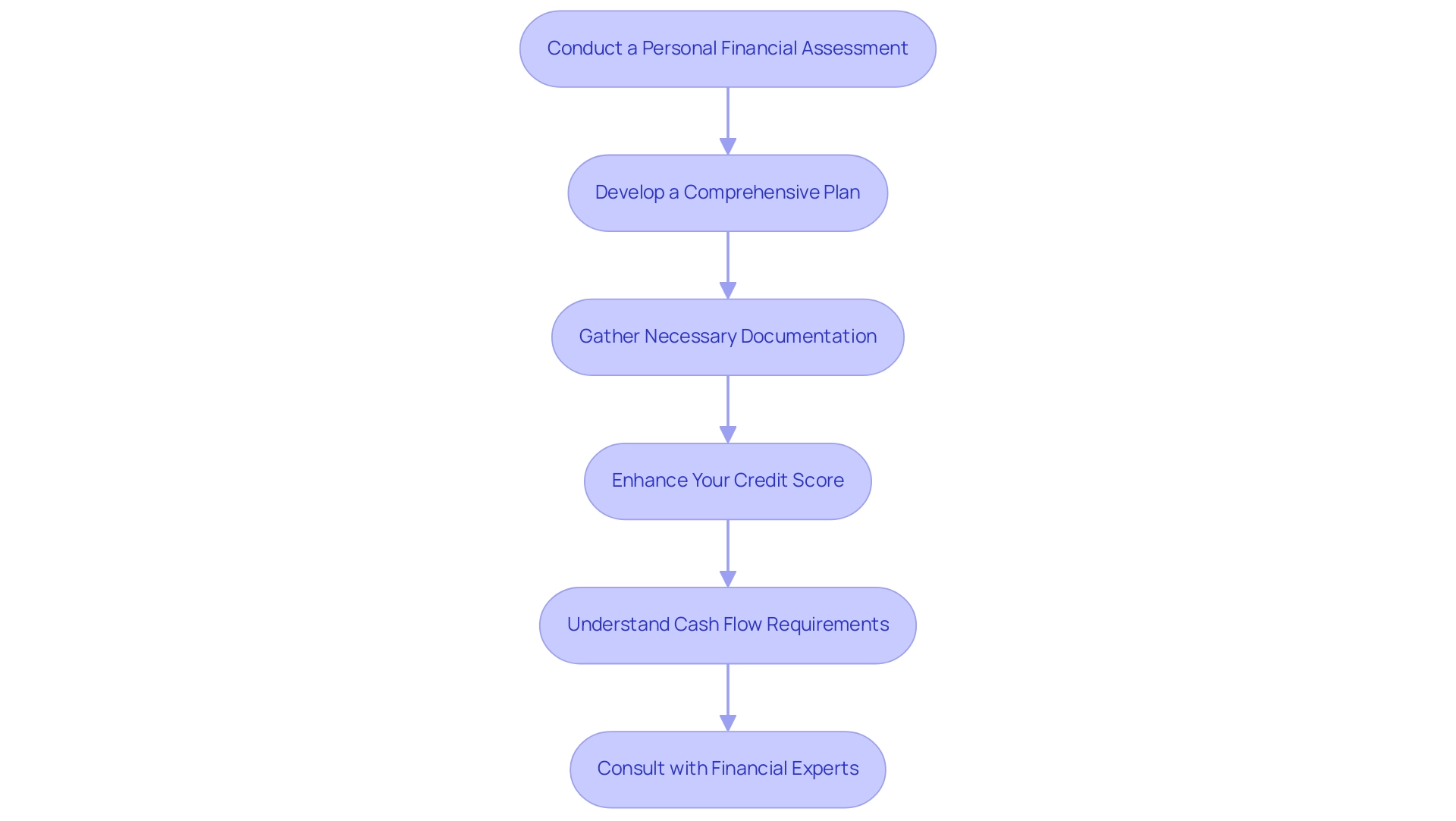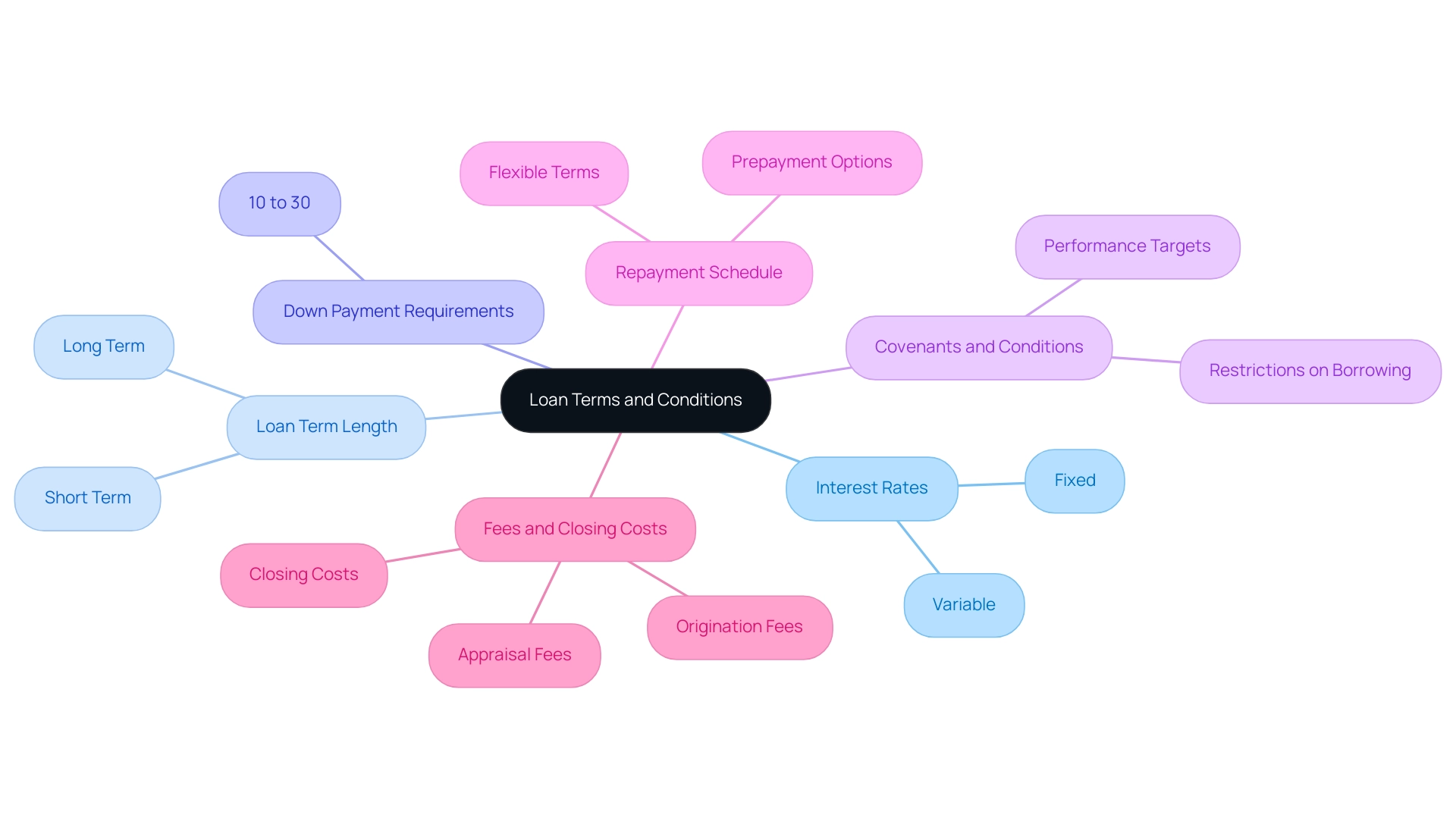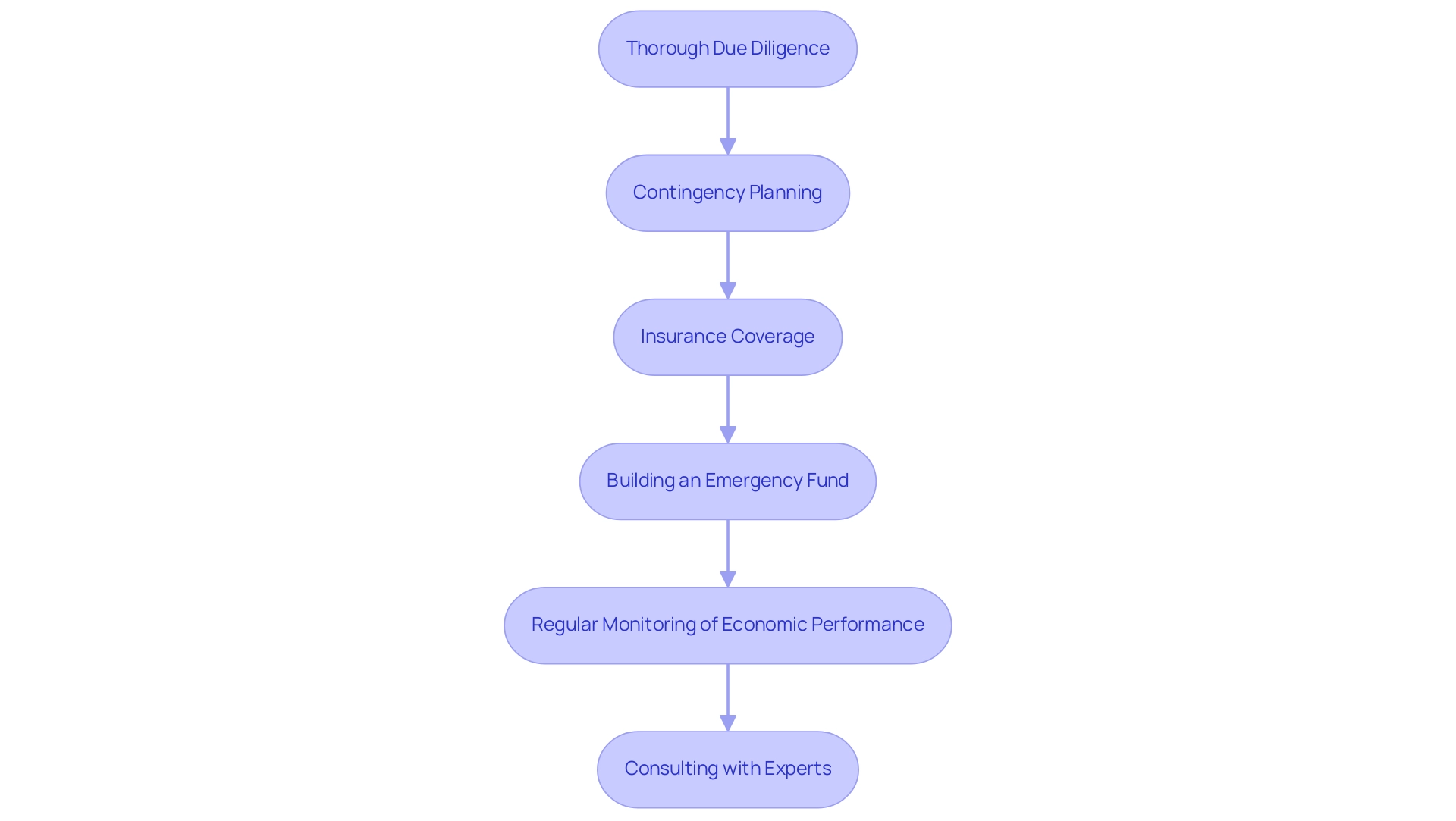Introduction
Acquiring an existing business can be a transformative step for aspiring entrepreneurs, yet it often comes with a complex web of financing options and considerations. From traditional bank loans to innovative crowdfunding strategies, the choices available can feel overwhelming. Understanding how to navigate this financial landscape is crucial for making informed decisions that align with long-term goals.
This article delves into various financing avenues, essential preparatory steps, and risk management strategies, equipping potential buyers with the knowledge needed to embark on their acquisition journey with confidence. Whether it’s assessing a business’s value or comprehending loan terms, each section provides valuable insights to ensure a successful transition into ownership.
Exploring Financing Options for Business Acquisition
When embarking on the journey of acquiring an existing business, it’s essential to explore a variety of options for financing the purchase of an existing business, each suited to different circumstances and goals. However, it’s equally important to approach this endeavor with a comprehensive budget that balances both fixed and variable costs, optimizing essential and discretionary expenses for long-term economic health. A well-crafted budget serves as the backbone of your financial planning, ensuring that you allocate resources wisely.
- Traditional Bank Loans: Many banks offer loans specifically designed for company acquisitions. Applicants typically need a robust proposal and a solid credit score. Current trends indicate that interest rates may vary significantly, making it crucial to shop around for the most favorable terms. In 2024, traditional bank loans remain a primary financing avenue despite the complexities involved in the approval process.
- SBA Loans: The Small Business Administration (SBA) plays a pivotal role in facilitating acquisitions by offering guarantees to lenders, thereby easing the borrowing process. With favorable terms including lower down payment requirements, SBA loans are particularly advantageous. Recent statistics indicate a higher approval rate for SBA loans, which is encouraging for potential buyers. For example, a commercial printing company recently obtained a $5 million SBA loan for debt refinancing, illustrating how these loans can significantly enhance economic terms for purchasers and emphasizing their potential advantages in practical situations.
- Seller Financing: This method enables the seller to receive payment in installments over time, alleviating the immediate monetary burden on the buyer. Such arrangements can make transitions smoother, as they often include flexible terms negotiated directly between the two parties.
- Investors and Venture Capitalists: For some buyers, seeking out investors willing to provide capital in exchange for equity can be an effective strategy. While frequently linked to startups, this option also pertains to established companies seeking a financial boost.
- Personal Savings or Family Loans: Utilizing personal savings or borrowing from family members can be a straightforward approach to fund a purchase. However, it’s essential to consider the potential risks and implications of combining personal finances with commercial transactions.
- Crowdfunding: Emerging as a viable option, crowdfunding platforms enable individuals to invest small amounts in entrepreneurial ventures. This method is particularly effective for unique or innovative business models that attract public interest.
Each financing option for financing the purchase of an existing business has its own set of advantages and challenges. As you navigate this process, remember that educating yourself about various investment vehicles empowers you to make informed decisions that can lead to long-term monetary rewards. Collaborating with a financial consultant can offer invaluable insights customized to your particular needs, ensuring you make informed choices in your purchasing journey.
Additionally, for personalized assistance, consider connecting with a BMO Private Wealth professional or locating a branch to explore your funding options further. As a COO in the travel technology industry wisely stated, “Let’s Get Started >” with a consultation to clarify the best path forward.

Preparing for Financing: Key Considerations and Steps
To prepare effectively for funding a business acquisition, consider the following steps:
-
Conduct a Personal Financial Assessment: Evaluate your current financial situation, including assets, liabilities, and credit score. This will help you understand how much you can afford to invest and what type of financing you may qualify for.
-
Develop a Comprehensive Plan: A well-structured plan is essential for convincing lenders or investors of your viability as a buyer. Include details about the business’s current performance, future growth prospects, and how you plan to manage operations.
-
Gather Necessary Documentation: Lenders will require various documents, such as tax returns, proof of income, and personal financial statements. Having these ready can expedite the application process.
-
Enhance Your Credit Score: If your credit score is below ideal levels, take measures to boost it before seeking funding. This might include paying down debt or correcting any inaccuracies on your credit report.
-
Understand Cash Flow Requirements: Lenders will want to see evidence of cash flow that can service the debt. Prepare projections based on realistic scenarios to demonstrate the organization’s ability to generate sufficient income post-acquisition.
-
Consult with Financial Experts: Collaborating with specialists who focus on enterprise purchases can offer important perspectives and help in managing intricate funding alternatives. They can assist in customizing a funding strategy that aligns with your objectives.
By following these preparatory steps, potential purchasers will be better equipped to secure the necessary financing for financing the purchase of an existing business and make informed decisions throughout the acquisition process.

Assessing the Business Value
When evaluating the value of a company, prospective buyers should consider several valuation methods to gain a comprehensive understanding of its worth:
- Asset-Based Valuation: This method determines the overall worth of an organization’s tangible and intangible assets, such as equipment, inventory, and intellectual property. It offers a clear snapshot of what the company owns, enabling buyers to gauge the minimum value based on assets alone.
- Income-Based Valuation: This method emphasizes the entity’s income-generating potential, typically utilizing discounted cash flow (DCF) analysis. DCF estimates future cash flows and discounts them to their present value, providing insight into the organization’s profitability and financial viability. As noted in the Disney acquisition of 21st Century Fox, which used DCF and Comparable Company Analysis (CCA), this method is crucial for understanding the value derived from an extensive content library and potential synergies with existing assets.
- Market-Based Valuation: By comparing the entity to similar companies that have recently sold, this method provides a benchmark for pricing, facilitating a fair market value determination. It is particularly useful in competitive markets where recent sales data can inform realistic pricing strategies.
- Professional Appraisal: Hiring a valuation expert can provide an impartial assessment that enhances negotiating stances and assists in obtaining funding. This professional insight is especially valuable in complex transactions where nuanced understanding is required.
- Reviewing Financial Statements: A thorough examination of the organization’s financial statements, including profit and loss statements and balance sheets, unveils critical insights into its financial health and operational performance. This analysis assists purchasers in recognizing trends and possible warning signs that may affect their buying choices.
By utilizing these valuation techniques, buyers can enhance their comprehension of a business’s value and make informed decisions about financing the purchase of an existing business that align with their purchasing goals. For instance, AT&T’s purchase of Time Warner in 2018 for $85 billion exemplifies how a strategic combination of DCF and asset-based valuation can drive significant investment decisions, particularly when focusing on valuable content libraries and vertical integration strategies. This case emphasizes the significance of thorough valuation evaluations in high-stakes transactions.

Understanding Loan Terms and Conditions
When considering financing the purchase of an existing business, it’s crucial to understand the following terms and conditions:
- Interest Rates: Know whether the interest rate is fixed or variable, as this will impact your payment amounts over time. Higher interest rates can significantly increase the overall cost of financing.
- Loan Term Length: The duration of the loan affects monthly payments and total interest paid. Longer terms typically have lower monthly payments but may incur higher total interest costs.
- Down Payment Requirements: Many lenders require a down payment, which can range from 10% to 30% of the purchase price. Understanding these requirements helps buyers plan their finances accordingly.
- Covenants and Conditions: Lenders may impose certain covenants or conditions, such as performance targets or restrictions on additional borrowing. It’s vital to understand these to avoid potential pitfalls.
- Repayment Schedule: Review how the repayment schedule is structured, including whether it allows for prepayment without penalties. Flexibility in repayment terms can be advantageous if your financial situation changes.
- Fees and Closing Costs: Be aware of additional charges associated with the loan, including origination fees, appraisal fees, and closing costs, which can add to the overall expense of funding.
Having a clear understanding of these terms will enable buyers to engage in more productive discussions with lenders regarding financing the purchase of an existing business and secure support that meets their needs.

Identifying Potential Risks and Mitigation Strategies
To effectively manage risks associated with financing an acquisition, consider the following strategies:
- Thorough Due Diligence: Conduct a comprehensive review of the company’s monetary records, legal standing, and operational practices to identify any red flags or potential issues.
- Contingency Planning: Develop a contingency plan that outlines how to respond to potential challenges, such as cash flow shortages or unexpected expenses.
- Insurance Coverage: Ensure that the company has adequate insurance coverage to mitigate risks related to liability, property damage, and interruptions.
- Building an Emergency Fund: Set aside resources that can be used in case of unforeseen circumstances, providing a buffer during challenging periods.
- Regular Monitoring of Economic Performance: Establish metrics to assess the organization’s economic health post-acquisition. Regular assessments can help you identify concerns early and take corrective actions.
- Consulting with experts, such as financial advisors, accountants, or mentors, is crucial for gaining insights into managing risks effectively and making informed decisions when financing the purchase of an existing business. By proactively identifying and addressing potential risks, buyers can enhance their chances of a successful transition and secure their investment in the acquired business.

Conclusion
Navigating the complexities of financing an existing business acquisition is a crucial step that can define the success of aspiring entrepreneurs. With a range of options available—from traditional bank loans and SBA loans to innovative solutions like crowdfunding and seller financing—each avenue presents unique advantages and challenges. Understanding these options is essential for crafting a financial strategy that aligns with personal goals and business needs.
Preparation is key in this journey. Conducting a thorough personal financial assessment, developing a robust business plan, and gathering necessary documentation can significantly streamline the financing process. Moreover, assessing the business’s value through various valuation methods allows potential buyers to make informed decisions, ensuring that they secure financing that reflects the true worth of the business.
Equally important is the comprehension of loan terms and identifying potential risks. By understanding interest rates, repayment schedules, and the implications of covenants, buyers can engage effectively with lenders. Additionally, implementing risk mitigation strategies, such as thorough due diligence and contingency planning, can safeguard investments and enhance the likelihood of a successful acquisition.
In summary, the journey of acquiring a business is filled with challenges that can be navigated successfully with the right knowledge and preparation. By leveraging comprehensive financial strategies and maintaining a proactive approach to risk management, aspiring entrepreneurs can embark on their acquisition endeavors with confidence, ultimately paving the way for long-term success.


